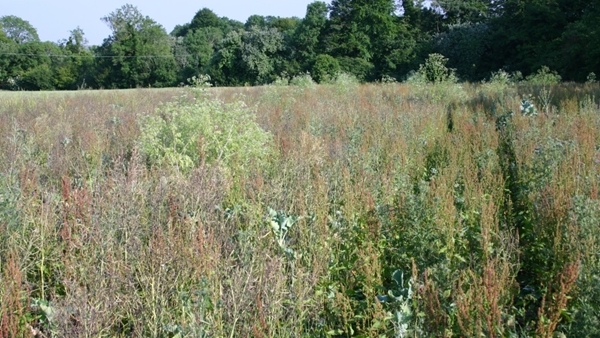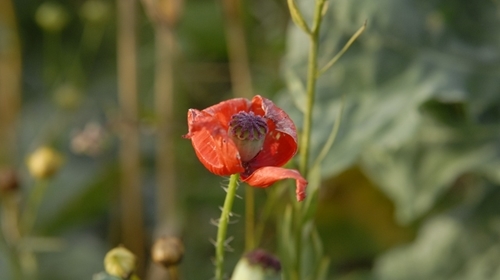
5 minute read
By Mike Swan, GWCT Head of Education
Over the next month or so I shall be helping to lead a couple of GWCT shoot walks each week. These are wonderful evening outings, with great people who love shooting and the countryside. Our generous hosts will normally have gone to some trouble to organise things, as they expose themselves and their ground to the critical gaze of a gang of GWCT members and their guests.
One of the things that almost invariably happens is a last minute tidy up of the venue. If this involves recycling some scrap that should have gone ages ago, well and good, but too often it goes too far, also resulting in heavy handed use of the strimmer to clear away ‘unsightly’ weeds and rough grass. Sadly, this can easily expose the carefully hidden nest of a pheasant, partridge or duck, and even if the bird does not desert because of the disturbance, its chance of successfully hatching before some predator or other spots it is now very low.
Natural seasons and traditional agriculture
Our native wildlife is beautifully adapted to take advantage of the annual cycle of weather and growth that our position on the globe dictates. Grey partridges, for example, generally choose nest sites in dead grass and start to lay around the beginning of May, when the new spring growth will rapidly help hide a nest. This results in a peak of hatching around the longest day, when the world has warmed up and the countryside is full of soft squishy insect larvae for their chicks to feed on. Their timing also fits with several thousand years of traditional mixed farming, with the chicks well grown and able to escape to alternative cover before harvest. By then their need for insects has dropped away, and a mix of weed seeds and stubble gleanings will sustain them deep into autumn.
Corncrakes, on the other hand, have just about faded from memory as summer migrants over most of the British Isles, just clinging on in the far north and northwest. I have never heard one, but to my parent’s generation their croaking calls were a familiar sound of childhood summer. Before the use of artificial fertilisers speeded up spring growth, the meadows were mostly cut late enough to allow the first broods to hatch and escape, but modern intensive farming, with the emphasis on early grass and cutting for silage spoilt that fine balance. On the other hand, not cutting would not be a help either; the annual mowing of hay created an open structure that was ideal for the birds.
Grey partridges and silage
In the late 1940s and 50s, widespread cutting of grass as silage, rather than waiting for it to ‘ripen’ into hay, was a new phenomenon, and the fact that it was heavily fertilised to speed early growth made it attractive nesting cover for partridges. The GWCT’s predecessor, ICI game research, spent considerable effort developing “flushing bars” to fit to the front of tractors, so that at least the hens could be saved to try again, even if their exposed nests were virtually bound to be predated. Sadly, this was largely in vain; steadily thicker crops, and ever faster and more powerful tractors, made such devices impractical in the extreme.
Today the issue of grey partridges and silage has largely gone away, as farming has become less mixed. Most silage is grown and cut as part of intensive livestock systems, and partridges have pretty much died out in the main livestock areas. They really only hang on in mainly arable countryside, where early mowing issues are not likely to be a problem.
A mowing routine
So, when can we cut the rough without risk to nesting birds? Well, in the old days, hay time came in July, and then harvest followed into late summer and autumn, so I suggest leaving the long grass and nettle patches uncut till mid-July. If you want tidy verges before then, please cut early, by the end of March. This will be before most nesting starts, and the resulting short sward will be unlikely to attract nesting game, or even songbirds like corn buntings and yellowhammers. You can then mow as regularly as you wish, all summer long, without risking significant harm.
That said, if your mowing is mainly to satisfy your sense of what is tidy, please think twice. Just as gardeners are being asked to mow less and leave more wildlife habitat, so farmers should question whether they really need to mow the weedy verges and corners at all. In truth, most of what grows here is not invasive, so its not a threat to production.

Nectar Flower Mixes
Flower rich areas for pollinators are a popular conservation choice and if they are in schemes the rules often ask for half the area to be mown in late June to stimulate a second flush of flowers. This could hardly come at a worse time for ground nesting birds, so there is usually a let-out clause to this effect. Personally, I would always invoke this, and not cut, just in case. Long ago I studied pollination for my PhD, so I know a bit about this, and it seems to me that you can choose an array of species for these pollinator mixes that results flowering all summer long, with no need to mow, and mash up other wildlife in June.
Next year’s nests and this year’s grass
Please also remember that dead grass from the previous year is the starting point of many a nest. Alongside the grey partridges, many species of farmland birds choose nesting sites in tussocky dead grass at the base of a hedge, where they are well hidden from prying eyes. Mowing in late summer and autumn effectively destroys this valuable spring cover, because there is not enough time for it to regrow before winter.
So, please do not mow out hedge bases just for the sake of it; most of the time the rough grass will settle to something stable that can be left indefinitely. If you do have problems with invasive weeds, or perhaps suckering blackthorn, then think in terms of selectively mowing where you need to but not for the entire length of the hedge.
Trimming hedges is clearly important for the farmer, to prevent them getting ever wider and gobbling up productive farmland. However, there should be no need to do this on an annual basis. A trim up every second or third year should be enough to keep things in order, and the best bet is to do some hedges each year, so that the rest remain untouched. To get best effect you need to trim both sides of the hedge, as well as the top, in the same winter, but it helps to scatter the cutting across the farm so that there are always alternative nesting sites nearby.
With the intensity of modern farming, rough grass areas are increasingly important as a game and wildlife habitat in a shrinking countryside. Putting wildlife as the top priority in the management of these areas may result in a bit of scruffiness, but it does not really threaten productivity, and shoots can do their bit by becoming advocates for the rough corners when farmers do not properly understand this.
This artcle originally appeared in Shooting Times.